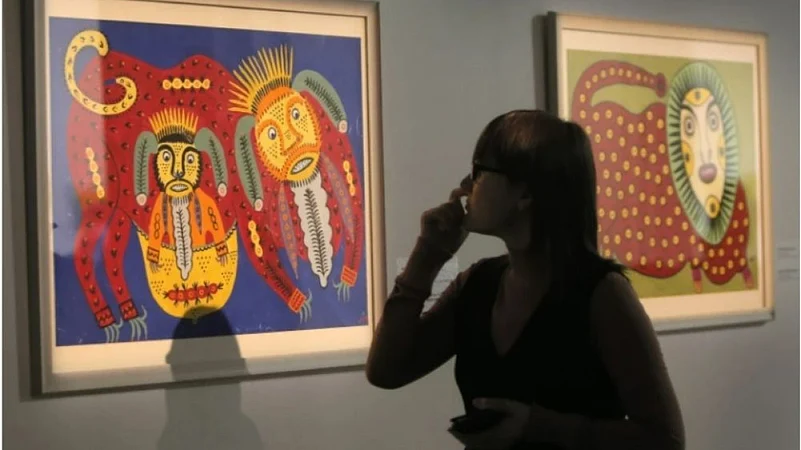Around 25 paintings by celebrated Ukrainian artists were burnt as the Russian invasion in eastern Ukraine continues unabated. Local museums housing the paintings have been destroyed by the Russian forces in Ivankiv near Kyiv. The museum reportedly had the exceptional works of the world-famous Ukrainian folk art painter Maria Pryimachenko, famous for her works in the 'naive art' genre. The eastern city of Kharkiv, home to a number of museums, cathedrals and historic neighbourhood is under heavy attack from the Russian forces. The National Museum of the History of Ukraine, cultural heritage of World War II, on the southern outskirts of Kyiv, is reported to have moved important items in its collection to the basement of the building.
Amid mounting tensions and explosions between Ukraine and Russia, Ukrainian scholars are warning of a “cultural catastrophe” befalling the country.
According to a report by the Guardian, Fedir Androshchuk, the director of the National Museum of the History said that he was attempting to safeguard the museum from attack or looting by the Russian forces. Androschuk, in an email, wrote, “The museum is located in the middle of a rich cultural heritage area near three fine churches, but also close to some possible targets (the Ukrainian security service and border forces).”
Taking to Twitter, the Ministry of Foreign Affairs, Ukraine said, “As a result of Russian invasion, about 25 works by outstanding Ukrainian artist Mariia Pryimachenko were burned. The paintings were stored in Ivankiv Museum, Kyiv region. She created world-famous masterpieces. Her special gift and talent captivated Pablo Picasso. Two-headed chicken, 1977.”
Ukraine’s museum and artefacts at risk
Ukraine’s art galleries and museums are resorts of Ukrainian and Russian art, folk art, classic art and Byzantine artefacts. It is the place of masterpieces by celebrated painters including Giovanni Bellini, Francisco Goya, and Jacques-Louis David. Russia’s consistent invasion into the Ukrainian territory has now posed a threat to this ancient heritage.
There are a total of seven heritage sites in Ukraine including St Sophia Cathedral in Kyiv. Founded by the 'Kyivan Rus' in the 12th century, it contains unique mosaics and frescoes from the early 16th century. Besides, the old quarter of Lviv, which lies 70 km from Poland, is also a world heritage site. The entire city dates back to the 13th century.
The Ivankiv Museum housed the historical artwork by Maria Pryimachenko. The destruction of Pryimachenko’s art has been widely condemned across social media. One of the country’s best-known painters, Pryimachenko, was born to a peasant family and her work drew from local mythology and folklore. Her work was all about depicting fantastical beasts that came to her dreams.
In his email, Fedir Androshchuk further stated, “Four museums – in Vinnytsia, Zhytomyr, Sumy and Chernihiv – had managed to take down and protect their main exhibitions. In Vinnytsia, the museum building is now partly used for internally displaced people. So far I have not heard that any of the aforementioned museums has been subject to looting or attack,” reports Guardian.
Maria Pryimachenko. Priyamchenko, who was born to a family of peasants, drew her work around folklore, local mythology and depicted fantastical beats that came to her dreams. Several of her works have been featured on Ukraine's postage stamps and she was awarded Ukraine's highest cultural honour, the Shevchenko National Prize, in 1966. To recognise her contributions to the field of folk art, UNESCO declared 2009 the year of Maria Prymachenko. The great Spanish master Pablo Picasso was captivated by Prymachenko’s talent, “I bow down before the artistic miracle of this brilliant Ukrainian.”
Artists up in rage
Artists across the world have widely condemned the destruction of the renowned art and artefacts of Ukraine. Over the past week, major cultural players-- including some within Russia -- have reacted to the invasion of Ukraine by cancelling shows and applying pressure to the country's art institutions.
According to international media, Ukrainian monuments, which are at risk, represent “centuries of history from the Byzantine to the baroque periods” and UNESCO world heritage sites.
The United States National Committee of the International Council of Museums has said, “The current conflict has taken lives, displaced tens of thousands of residents, and destabilized the international order. That it also seeks to destroy — recklessly and intentionally — the heritage, institutions, and access to the history of a great nation and palimpsest of past cultures abrogate the reasonable expectations of civil society and the treaty obligations of which the United States, Russia, and Ukraine are all signatories.”
However, experts fear the annexation of Ukrainian art galleries and museums in Kyiv, as the capital city has always been of special interest to Russian President Vladimir Putin in his interpretation of Russian history.
















